
Stellaria graminea is a species of flowering plant in the family Caryophyllaceae known by the common names common starwort, grass-leaved stitchwort, lesser stitchwort and grass-like starwort.
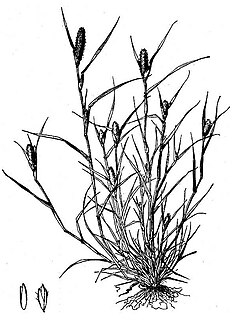
Crypsis is an African and Eurasian plant in the grass family sometimes referred to as pricklegrass.
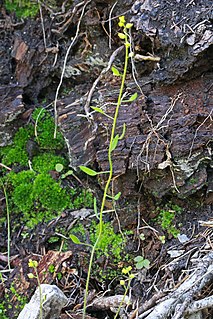
Draba albertina is a species of flowering plant in the mustard family known as the Arc dome draba,slender draba or slender whitlow-grass. This plant is native to western North America, where it grows at high elevations from Arizona to Alaska and northern Canada. Like many species of Draba, it can grow in alpine and Arctic climates. This is a biennial or short-lived perennial with a single stem or several branching stems which may be very short or up to 40 centimeters in height. The appearance of the plant varies depending on the climate it endures. The leaves are up to 4 centimeters long, roughly hairy, and mostly basal. The stem bears an inflorescence of up to about 30 small yellow flowers. The fruit is a silique up to two centimeters long.

Festuca idahoensis is a species of grass known by the common names Idaho fescue and blue bunchgrass. It is native to western North America, where it is widespread and common. It can be found in many ecosystems, from shady forests to open plains grasslands.

Achnatherum occidentale is a species of grass known by the common name western needlegrass. It is native to western North America from British Columbia to California to Colorado, where it grows in many types of habitat. This is a tufting perennial bunchgrass forming tight clumps of erect stems up to about 120 centimetres (47 in) in maximum height, but sometimes much shorter. The hairlike leaves are less than a millimeter wide and may have rolled edges. The inflorescence is up to 30 centimetres (12 in) long, with each hairy spikelet bearing an awn up to 4 or 5 centimeters long. The awn is kinked twice.
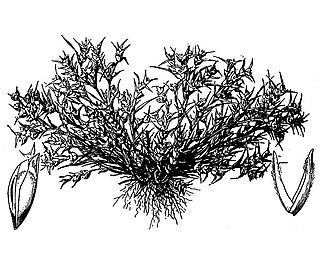
Crypsis vaginiflora is a species of grass known by the common name modest pricklegrass. It is native to North Africa but it can be found in other parts of the world as an introduced species, including the western United States, particularly California, where it is common in wet habitat such as vernal pools. It is an annual grass forming mats of green, prostrate stems not generally exceeding 30 centimeters long. The stems are enveloped in the sheaths of the leaves, the small blades of which break off. The inflorescence is a dense panicle usually no more than 1.5 centimeters long tucked into the sheaths of the uppermost leaves.

Lappula squarrosa is a species of flowering plant in the borage family known by several common names, including European stickseed, bur forget-me-not, bluebur, and bristly sheepbur. It is native to Europe and Asia, where it is common, and it is an introduced species in much of North America and Africa. It is well known as a noxious weed where it is naturalized and also in many parts of its native range. This is an annual herb producing an erect stem often with sprays of many long, bending branches, its form varying in different regions and climates. The plant may approach a meter in height. The stems are lined with linear to oval leaves up to 5 centimeters long and coated in whitish hairs, and the herbage emits a scent generally considered unpleasant. The inflorescence is a long, leafy raceme of tiny flowers near the ends of the branches. Each flower is 2 to 4 millimeters wide with five light blue corolla lobes. White-flowered plants are occasionally seen. The fruit is a cluster of four nutlets which are coated in hooked prickles. The seeds are dispersed when the prickles get caught on animal coats and human clothing, and when they are moved by wind.
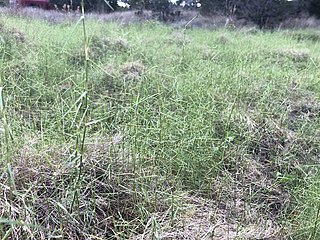
Muhlenbergia utilis is a species of grass known by the common name aparejograss.

Poa glauca is a species of grass known by the common names glaucous bluegrass, glaucous meadow-grass and white bluegrass. It has a circumboreal distribution, occurring throughout the northern regions of the Northern Hemisphere. It is also known from Patagonia. It is a common grass, occurring in Arctic and alpine climates and other areas. It can be found throughout the Canadian Arctic Archipelago in many types of habitat, including disturbed and barren areas.

Puccinellia lemmonii is a species of grass known by the common name Lemmon's alkaligrass. It is native to western North America, particularly the northwestern United States, where it grows in moist, saline soils.

Schismus arabicus is a species of grass known by the common name Arabian schismus. It is native to northern Africa, temperate Asia, and it is also known as an introduced species in the southwestern United States. It grows in many types of habitat, including disturbed areas. It is an annual grass with stems growing up to 16 centimeters long and lined with threadlike leaves. The short inflorescence bears spikelets under a centimeter long.

Schismus barbatus is a species of grass known as common Mediterranean grass and kelch-grass. It is native to Eurasia, and it is also known as an introduced species in the southwestern United States. It grows in many habitats, including disturbed areas. It is an annual grass growing in small clumps. The stems grow up to 27 centimeters long and are lined with threadlike leaves. The short inflorescence bears spikelets under a centimeter long.

Setaria verticillata is a species of grass known by the common names hooked bristlegrass, rough bristle-grass and bristly foxtail. It is native to Europe, but it is known on most continents as an introduced species and often a noxious weed. It is a hardy bunchgrass which grows in many types of urban, cultivated, and disturbed habitat. It is a weed of many types of agricultural crops, growing in vineyards and fields. Herbicide-resistant strains have been noted.

Spartina gracilis is a species of grass known by the common name alkali cordgrass.

Sphenopholis obtusata is a species of grass known by the common names prairie wedgescale and prairie wedge grass. It is native to North America where it is widespread across southern Canada and the United States. It occurs in many types of habitat, including prairie, marshes, dunes, and disturbed areas.
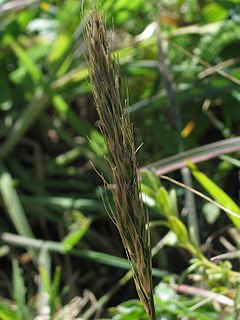
Trisetum canescens is a species of grass known by the common names tall trisetum and tall false oat.
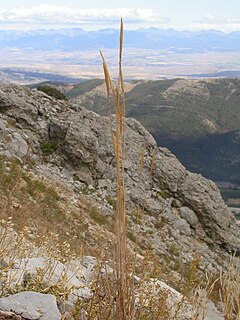
Trisetum spicatum is a species of grass known by the common name spike trisetum and spike false oat. It is native to North America, Eurasia, and South America. In North America it occurs throughout northern regions, including northern sections of the United States and most all of Canada, its range continuing to Greenland. It is widespread throughout the Canadian Arctic Islands. The grass occurs in a variety of Arctic and alpine habitat types, as well as many types of mountainous habitat in regions farther south. It is a perennial grass forming clumps of erect stems ranging in height from just a few centimeters to over one meter. The narrow leaves are mostly located around the bases of the densely clumped stems. The inflorescence is a narrow spike a few centimeters long or up to 30 to 50 centimeters in maximum length. The spikes are green to purple or brownish and shiny.
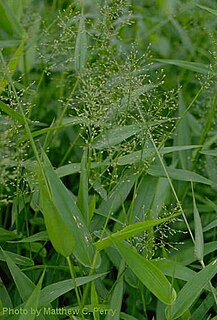
Dichanthelium clandestinum is a species of grass known by the common name deertongue. It is native to eastern North America, including eastern Canada and the eastern United States.
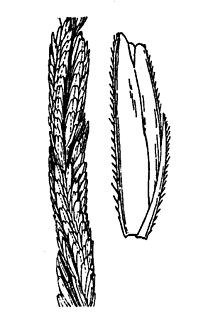
Spartina spartinae is a species of grass known by the common names gulf cordgrass and sacahuista. It is native to the Americas, where it occurs from the Gulf Coast of the United States south to Argentina.

Setaria palmifolia is a species of grass known by the common names palmgrass, highland pitpit, hailans pitpit, short pitpit, broadleaved bristlegrass, and knotroot. In Spanish it is called pasto de palma and in Samoan vao 'ofe 'ofe. It is native to temperate and tropical Asia. It is known elsewhere as an introduced, and often invasive, species, including in Australia, New Zealand, many Pacific Islands, and the Americas.




















